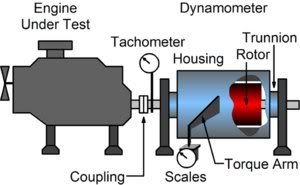The torque of an engine is measured directly in a dyno. Basically the engine is forced to rotate a lever arm and at the end of the lever arm is a load sensor that measures the torque coming from the engine. To get the absolute torque rating at any RPM for any engine then the loading on the lever arm should be enough to hold the engine stable at the target RPM at WOT.
Now lets think about this: The torque of the engine is measured in full only when the system is standing still (and the RPM is totally stable). Now if you set a target RPM for every 100rpm in the operating range you could put together a nice torque curve. Then power is easily calculated. However this way of measuring engine output takes a long time and needs adjustable loads and a way to dissipate all the heat generated.
Now most dynos used for cars do not hold the engine at a stable RPM to measure torque. Instead most automotive dynos have a set work load and the engine is forced to do that work at WOT. The faster it can do the work (normally accelerating a rotating weight) the more power the engine is putting out. So in actual fact most dynos out there measure power directly.
A big hint is the fact that many dyno charts use speed instead of RPM to show the power curve. You cannot calculate the torque needed to accelerate to any speed but there is an easy to calculate minimum power requirement to accelerate to any speed. The computer normally does this simple calculation coupled with several adjusting factors to decide the actual power output of the engine.

Originally Posted by
revetec
I pose to you that a steam train has 5000Nm of torque but only 300kW. It can pull a 20 carriage train from a standing start quite easily. Put your 300kW car with 500Nm in front and try to pull it. You wont move it easily.
You would be wrong in every way. If both systems are allowed to maintain their respective outputs of 300kW and transfer that power 100% then you will find that the car will accelerate faster (because it is lugging the 20 carriage train and the 1000-2000kg of car in stead of the 10000-60000kg of engine train. In real life what helps the train is the immense weight of itself creating massive traction which allows it to output the 300kW at low speeds. Nothing to do with it's torque.

Originally Posted by
revetec
Torque is all important at the lower rev ranges for acceleration while horsepower is low. You may have 300kW on tap, but at what RPM. If it is at 6,000rpm the power at 3,000rpm may be 150kW. So if the torque is higher at lower RPM then not only is your power going to be higher at this point but it will accelerate quicker to 6,000rpm. What I am trying to say is that if you provide higher torque at a lower RPM then your power curve will rise faster and be more flat through the midrange making it accelerate stronger through the rev range. So peak power is not as important as a wide flat power range provided by a good torque curve if you want the fastest time between A and B.
I never said peak power is the be all end all. The power curve is. Torque on it's own means nothing however I agree that you should try to tune an engine to have a flat torque curve (more pratically a slightly rising one) as this will get the best power curve, which is what does all the wok. You are perpetuating the myth that at low rpm, torque mystically becomes more important than power. This is totally wrong. Higher torque at lower rpm is only beneficial because that means that you are making more power at low rpm. The power curve is everything. Instead of claiming that you engines make such great low rpm torque you will impress people much more if you claim that you can generate much more power at low rpm.

Originally Posted by
revetec
Similarly, if you are cruising in a high gear and you approach a hill. The lower torque engine will have to gear down to increase horsepower before the high torque engine has to. It's all about driveability and efficiency. A flat torque curve is most desirable in production cars as it gives a smooth even acceleration. People who like to drive harder may like the power peak feel. The heavier the vehicle, the more torque is desirable.
I partially agree with you. I would totally agree if you replaced the word torque with power. It is the power curve that dictates when you have to shift down a gear to continue up the hill. The heavier the vehicle the more you have to concentrate on creating the proper power curve.
Power, whether measured as HP, PS, or KW is what accelerates cars and gets it up to top speed. Power also determines how far you take a wall when you hit it
Engine torque is an illusion.




 Reply With Quote
Reply With Quote








